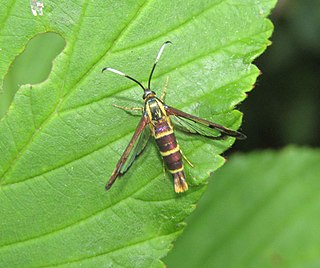Carmenta is a genus of moths in the family Sesiidae.
Carmenta albociliata is a moth of the family Sesiidae. It was described by Engelhardt in 1925. It is known from North America, including Texas and Arizona.
Carmenta anthracipennis, the liatris borer moth, is a moth of the family Sesiidae. It was described by Jean Baptiste Boisduval in 1875, and is known from the United States, including Florida, Texas, Massachusetts and Illinois.
Carmenta armasata is a moth of the family Sesiidae. It was described by Herbert Druce in 1892. It is known from Texas.
Carmenta auritincta, the Arizona clearwing moth, is a moth of the family Sesiidae. It was described by Engelhardt in 1925. It is known from south-eastern Arizona and northern Mexico.

Carmenta bassiformis, the eupatorium borer moth, is a moth of the family Sesiidae. It was described by Francis Walker in 1856, and is found in the United States from Massachusetts to Florida, west to Wisconsin, Kansas and Texas.
Carmenta engelhardti is a moth of the family Sesiidae. It was described by W. Donald Duckworth and Thomas Drake Eichlin in 1973. It is known from Arizona in the United States.
Carmenta tildeni is a moth of the family Sesiidae. It was described by Thomas D. Eichlin in 1995, and is known from the United States, where it is found in Arizona and southern Texas, and from Mexico.
Carmenta odda is a moth of the family Sesiidae. It was described by W. Donald Duckworth and Thomas Drake Eichlin in 1977. It is found in the United States from South Carolina to Florida.
Carmenta pallene is a moth of the family Sesiidae. It was described by Herbert Druce in 1889. It was described from Tabasco in Mexico, but it is also known from Arizona in the United States.
Carmenta prosopis is a moth of the family Sesiidae. It was described by Henry Edwards in 1882, and is known from northern Mexico, and south-western United States.
Carmenta welchelorum is a moth of the family Sesiidae. It was described by W. Donald Duckworth and Thomas Drake Eichlin in 1977. It is known from south-central Texas in the United States.
Carmenta wellerae is a moth of the family Sesiidae. It was described by W. Donald Duckworth and Thomas Drake Eichlin in 1976. It is known from southern Arizona in the US and northern Mexico. The habitat consists of mountains and foothills.
The cocoa fruit borer is a moth of the family Sesiidae. It was described by August Busck in 1910, and is known from Colombia and Venezuela.
Carmenta foraseminis is a moth of the family Sesiidae. It was described by Thomas Drake Eichlin in 1995, and is known from Panama, Colombia, Venezuela, and Brazil. The larva of the species have been found on plants of the species Gustavia angustifolia, Gustavia suberba, as well as plants in the genus Eschweilera, and on the pods of Theobroma cacao.
Carmenta flaschkai is a moth of the family Sesiidae. It was described by Eichlin in 1993. It is known from North America, including Texas.
Carmenta chromolaenae is a moth of the family Sesiidae. It is native to Venezuela, but was introduced to South Africa for the biological control of Siam weed.



